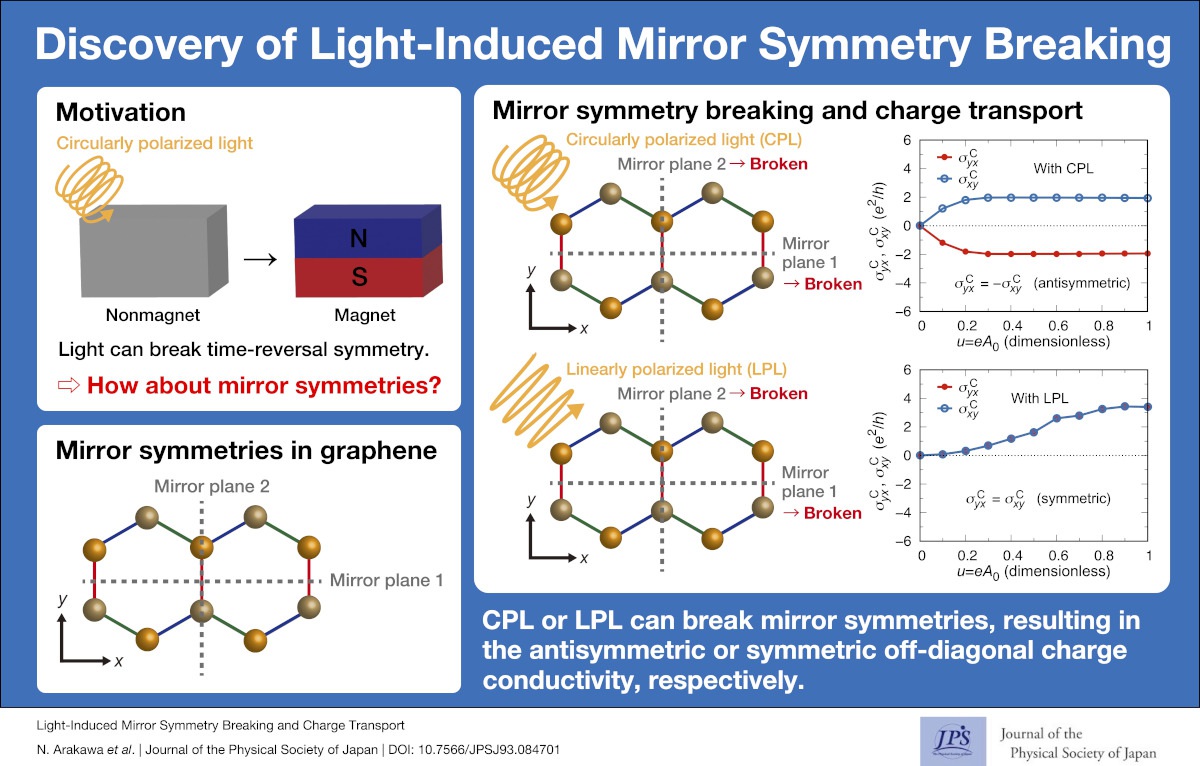Discovery of Light-Induced Mirror Symmetry Breaking
© The Physical Society of Japan
This article is on
Light-Induced Mirror Symmetry Breaking and Charge Transport
(JPSJ Editors' Choice)
J. Phys. Soc. Jpn. 93, 084701 (2024).
The authors discovered the light-induced mirror symmetry breaking, paving the way for controlling mirror symmetries via light and for realizing various phenomena utilizing the mirror symmetry breaking.

Light can break symmetries in time and space. For example, circularly polarized light can break the time-reversal symmetry. This time-reversal symmetry breaking can be used to generate the light-induced magnetization.
Despite several studies on the light-induced symmetry breaking, whether light can break mirror symmetries remains unclear.
Recently, we have demonstrated that circularly or linearly polarized light can break the mirror symmetries. We considered monolayer graphene periodically driven by circularly or linearly polarized light, and studied the effects of the light field on the mirror symmetries and charge transport. We demonstrated that the symmetries of the xz and yz mirror planes of monolayer graphene can be broken by circularly or linearly polarized light. We also observed that the mirror symmetry breaking can be characterized by the off-diagonal charge conductivity, which is the transport coefficient describing the charge current perpendicular to the applied electric field. The conductivity becomes antisymmetric or symmetric with respect to its indices when circularly or linearly polarized light, respectively, is applied. This difference is due to the difference in time-reversal symmetry.
This study discovered the light-induced mirror symmetry breaking, paving the way for the optical control of mirror symmetries and the realization of various phenomena utilizing the mirror symmetry breaking. This also indicates that the origin of the light-induced anomalous Hall effect, which is described by the antisymmetric off-diagonal charge conductivity, is not simply the light-induced time-reversal symmetry breaking, but a combination of this and the light-induced mirror symmetry breaking.
(Written by N. Arakawa on behalf of all authors.)
Light-Induced Mirror Symmetry Breaking and Charge Transport
(JPSJ Editors' Choice)
J. Phys. Soc. Jpn. 93, 084701 (2024).
Share this topic
Fields
Related Articles
-
Discovery of Unconventional Pressure-Induced Superconductivity in CrAs
Superconductivity
Electronic transport in condensed matter
2024-8-13
A new study has discovered pressure-induced superconductivity in the helimagnet CrAs, originating in the vicinity of the helimagnetic ordering, representing the first example of superconductivity in Cr-based magnetic systems.
-
Antiferromagnetism Induces Dissipationless Transverse Conductivity
Electronic transport in condensed matter
Magnetic properties in condensed matter
Electronic structure and electrical properties of surfaces and nanostructures
2024-7-24
An investigation using high-quality NbMnP crystals demonstrates that the anomalous Hall conductivity arising from antiferromagnetism is dissipationless, as expected from the intrinsic mechanism.
-
d2 Trimer and d3 Tetramer in a Pyrochlore Lattice
Dielectric, optical, and other properties in condensed matter
Electron states in condensed matter
2024-7-11
Based on the charge disproportionation of V3+ and V2+, the V3+(d2) trimers and V2+(d3) tetramers in the vanadium pyrochlore lattice of AlV2O4 are described by the orbitally-induced Peierls mechanism.
-
Structural Rotation and Falsely Chiral Antiferromagnetism: A New Combination Generating Ferrotoroidic State
Magnetic properties in condensed matter
Dielectric, optical, and other properties in condensed matter
2024-7-4
The ferrotoroidic state, an exotic state of matter with broken space inversion and time-reversal symmetries, was achieved by combining structural rotation and falsely chiral antiferromagnetism in PbMn2Ni6Te3O18.
-
Exploring Electronic States in BEDT-TTF Organic Superconductors
Superconductivity
Electronic transport in condensed matter
Magnetic properties in condensed matter
2024-4-24
This review, published in the Journal of the Physical Society of Japan, provides a comprehensive summary of the electronic states observed in BEDT-TTF type organic superconductors, including metal-insulator transitions, Mottness transitions, non-Fermi liquids, quantum spin liquids, and Bose-Einstein condensation.
